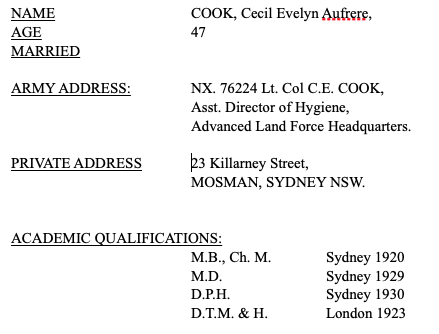APPLICATION OF
LT. COL. C.E. COOK, CBE, MD, DPH, DTM & H, AAMC
FOR THE POSITION OF
COMMISSIONER OF PUBLIC HEALTH, WESTERN AUSTRALIA.
13 Feb 45.
Public Service Commissioner,
PERTH WESTERN AUSTRALIA
Application is hereby made for appointment to the position of Commissioner of Public Health, Western Australia.



A.D.H. is the Representative of the Director of Hygiene A.M.F. on the staff of the Senior Medical Officer of the Formation to which attached. His duties include:-
(a) Hygiene Administration within the Formation;
(b) Advice to S.M.O. Formation upon all aspects of the epidemiology and control of disease affecting health of Troops;
(c) The training of Medical Officers and all ranks I field measures of disease control;(d) Supervision of anti-malarial measures in absence of Senior Malariologist.
PROFESSIONAL EXPERIENCE:
1923 – 25 During the tenure of this Wandsworth Fellowship, conducted research into the Epidemiology, treatment and control of Leprosy in Great Britain, Norway, Western Australia, Northern Territory, Queensland and New South Wales.
1924 In pursuance of Research into Epidemiology of Leprosy in Australia under Wadsworth Research Fellowship, made a survey of North Western Australia from ONSLOW to WYNDHAM in 1924. Attention was directed to –
- the incidence and epidemiology of leprosy in the white and native populations.
- incidence of other tropical diseases in native population.
- recommendations to Western Australian Dept. of Health, on provision of Medical Service and methods of disease control in North Western Australia.
1925 A similar medical survey of North Australia was made in 1925. Recommendations were submitted to Commonwealth Dept. of Health and these formed the basis of the national medical service subsequently established in the Northern Territory and North Western Australia.
1926 On staff of Australian Institute of Tropical Medicine, Townsville. Directed research into Epidemiology of hookworm in Cairns and hinterland N.Q.
1927 – 39 As Chief Medical Officer and Chief Protector of Aboriginals in Northern Territory, organised and developed a Medical Service adapted to the special conditions obtaining in the remote parts of tropical Australia.
The Northern Territory Medical Service so established subsequently served as a model for the North West Medical Service of W.A.
Organisation of the Northern Territory Medical Service involved:-
- A nationalised service of Medical and Health Officers.
- A Nursing service with provision for local training of nurses.
- Aerial medical service and aerial ambulance (distinct from A.I.M.)
- Maternal and Infant Welfare, Tuberculosis & V.D. Clinics.
- Medical Inspection of pre-school and school children.
- Establishment throughout the Territory of a chain of Hospitals and Medical Aid Posts.
- Routine Medical Inspection of natives and control of conditions of employment to safeguard health of white and native.
- Provision of native Hospitals and Medical Aid Posts.
- Development of a system of Leprosy Control and establishment of Leprosarium serving Northern Territory and, for some years, West Australia.
- Studies in acclimatisation and the incidence and control of diseases affecting white men in the Tropics.
- Eradication of malignant malaria from white and native population.
- A contributing Medical Benefit Fund entitling the subscriber and his dependents to free medical attention, hospitalisation, drugs and ambulance transport.
SPECIAL EXPERIENCE:

PUBLICATIONS:
“Epidemiology of Leprosy in Australia” – Commonwealth Dept. of Health Publication 1927
“Leprosy Problems” – Medical Journal of Australia, Dec 1926
“Observations on Epidemiology of Scrub Typhus” – Medical Journal of Australia, Nov 1944
Sundry reports to:
Commonwealth Dept. of Health;
Northern Territory Administration;
Federal Health Council;
New South Wales Parliamentary Committee on Hospital Administration
Commonwealth Parliamentary Standing Committee of Public Works (Hospital provision for N.T.)
Published from time to time in Annual Reports or Reports of proceedings.
TESTIMONIALS:
Not permissible to members of Commonwealth Public Service.
REFERENCES:
- Dr. J.H.L. CUMPSTON, Commonwealth Director-General of Health, Canberra, A.C.T.
- J.A. CARRODUS, Esq., Secretary Dept. of Interior, Canberra, A.C.T.
- Prof. Harvey SUTTON, Director, School of Public Health and Tropical Medicine, University of Sydney.
- Maj. Gen. S.R. BURSTON, Director General of Medical Services, Australian Military Forces, Melbourne.
- Brigadier, N.H. FAIRLEY, Director of Medicine, Australian Military Forces, Melbourne.
- Colonel E.V. KEOGH, Director of Hygiene and Pathology, Australian Military Forces, Melbourne.
- Group Captain A.H. BALDWIN, Advisor in Tropical Medicine and Hygiene, Headquarters, Royal Australian Air Force.
- A.O. NEVILLE, Esq., Dept of Native Affairs, Perth, Western Australia.
- Dr. E. EVERITT ATKINSON, Perth.
- Dr. G.R. TROUP, Perth.
- Dr. G. ASHBURTON THOMPSON, Perth.
HONOURS:
Cr. C.B.E. — 1935
Cilento Medal — 1935
(C E Cook) Lt. Col.